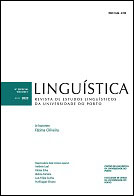Contrastive constructions with "mas," Syntagmatic Contrast, and Ellipsis of the TP
Abstract
In Portuguese, mas ‘but’ occurs in two different structural constructions, one mainly involving contrast between two non-sentential phrases, Contraste Sintagmático ‘Phrasal Contrast’, and the other contrasting two sentences and presenting ellipsis, TP ellipsis with polarity items. In languages as Spanish and German, contrastive coordination typically correlates two different conjunctions with two constructions exhibiting distinct values, the corrective and the counter-expectation value. Relying on work of the past two decades on adversative coordination with corrective and counter-expectation values, the current paper aims at determining to what extend it is possible to establish a univocal correlation between the values of the adversative coordination and the constructions of Contraste Sintagmático and TP ellipsis in portuguese. It is also our goal to develop a more accurate analysis of these constructions.
References
Anscombre, J.-C., & Ducrot, O. (1977). Deux mais en français? Língua, 43(1), 23-40.
Adam, J.-M. (1990). L’exemple des connecteurs : mais et certes. In Élements de Linguistique Textuelle. Théorie et Pratique de l’analyse textuelle (pp. 192-225). Mardaga.
Barros, C. (1998). De magis a mas: deriva semântica e pragmática. In J. Fonseca, & C. Barros (Eds.), A organização e o funcionamento dos discursos: estudos sobre o Português (Tomo 1, pp. 25-48). Porto Editora.
Barros, M. (2012). A Non-Repair Approach to Island Sensitivity in Contrastive TP Ellipsis. In Proceedings of the 48th Meeting of Chicago Linguistic Society (Vol. 48, Nº. 1, pp. 61-75). Chicago Linguistic Society (CLS).
Brucart, J. M. (1999). La ellipsis. In I. Bosque, & V. Demonte (Eds.), Gramática descriptive de la Lengua Española (Vol. 2, pp. 2787-2863). Editorial Espasa.
Canceiro, N. (2019, outubro 9-11). Haverá só um “mas” em Português Europeu? [Comunicação] XXXV Encontro Nacional da Associação Portuguesa de Linguística, Campus de Gualtar, Universidade do Minho, Portugal.
Canceiro, N. (2021). Construções de mas em estruturas corretivas e de negação de expectativas [Relatório de Projeto de Tese de Doutoramento]. Universidade de Lisboa. Flamenco
García, L. (1999). Las construcciones concesivas y adversativas. In I. Bosque, & V. Demonte (Eds.), Gramática descriptiva de la Lengua Española (Vol. 3, pp. 3805-3878). Editorial Espasa.
Franco, L. (2016). Adversative “corrective” coordination: further evidence for combining sub-clausal constituents. Revue Roumaine De Linguistique / Romanian Review Of Linguistics, 51(2), 125-142.
Hankamer, J. (1971/1979). Deletion in Coordinate Structures. Garland Publishing Inc. Hankamer, J., & Sag, I. (1976). Deep and Surface Anaphora. Linguistic Inquiry, 7(3),391-428.
Horn, L. (1985). Metalinguistic negation and pragmatic ambiguity. Language, 61(1), 121- 174.
Horn, L. (2001). A Natural History of Negation (2.ª ed.). CSLI. Lasnik, H. (2001). When Can You Save a Structure by Destroying It? North East Linguistics Society, 3(2), artigo 5.
Lasnik, H. (2005). The Syntax of Silence (revisto). Language, 81, 259-265.
Matos, M. G. A. P. (1992). Elipse do Predicado em Português - SV Nulo e Despojamento [Tese de Doutoramento]. Universidade de Lisboa. http://hdl.handle.net/10451/51579 Matos, G. (2003). Estruturas de coordenação. In M. H. M. Mateus, A. M. Brito, I. Duarte, I. H. Faria, S. Frota, G. Matos, F. Oliveira, M. Vigário, & A. Villalva (Eds.), Gramática da Língua Portuguesa (pp. 549-592). Editorial Caminho.
Matos, G., & Prada, E. (2005). Construções contrastivas de focalização: adversativas vs. concessivas. In Actas do XX Encontro NacionaK da Associação Portuguesa de Linguística (pp. 701-713). APL.
Matos, G. (2017). TP ellipsis with polarity particles. In R. Lopes, J. Avelar, & S. Cyrino (Eds.), Romance Languages and Linguistic Theory 12: Selected papers from the 45th Linguistic Symposium on Romance Languages (LSRL) (Vol. 12, pp. 141-157). John Benjamins.
McCawley, J. D. (1982). Parentheticals and discontinuous constituent structure. Linguistic Inquiry, 13(1),91-106.
McCawley, J. D. (1987). Some additional evidence for discontinuity. Syntax and Semantics – Discontinuous Constituency, vol.20 (pp.185-200). Brill.
Merchant, J. (2001). The syntax of silence: Sluicing, islands, and the theory of ellipsis. Oxford University Press.
Merchant, J. (2003). Remarks on stripping. Ms., University of Chicago.
Prada, E. (2000). Produção de construções adversativas no Português Europeu [Dissertação de Mestrado]. Universidade Aberta.
Reinhart, T. (1991). Non quantificational LF. In A. Kasher. The Chomskyan Turn (pp. 360-384). Blackwell.
Reinhart, T. (1991). Eliptical Conjunctions: Non Quantificational LF. In A. Kasher (Ed.), The Chomskyan Turn (pp.360-384). Blackwell.
Saab, A. (2008). Hacia una denti de la dentidade parcial en la ellipsis [Tese de Doutoramento]. Universidad de Buenos Aires.
Sousa, S. (2006). Contributos para o estudo das construções refutativo-rectificativas em Português Europeu [Dissertação de Mestrado]. Universidade de Coimbra.
Sousa, S. (2014). Contributos para o estudo da refutação em Português Europeu Contemporâneo [Tese de Doutoramento]. Universidade de Coimbra.
Steindl, U. (2017). The Gramar of Correction [Dissertação de Doutoramento]. University of Southern California.
Toosarvandani, M. (2010). Association with Foci [Dissertação de Doutoramento]. University of California.
Toosarvandani, M. (2013). Corrective but coordinates clauses not always but sometimes. Natural Language and Linguist Theory, 31(3), 827–863.
Vicente, L. (2010). On the syntax of adversative coordination. Natural Language and Linguist Theory, 28(2), 381-415.
Wurmbrand, S. (2017). Stripping and Topless Complements. Linguistic Inquiry, 48 (2), 341–366.
Downloads
Published
Issue
Section
License
Copyright (c) 2022 Linguística: Revista de Estudos Linguísticos da Universidade do Porto

This work is licensed under a Creative Commons Attribution-NonCommercial 4.0 International License.



